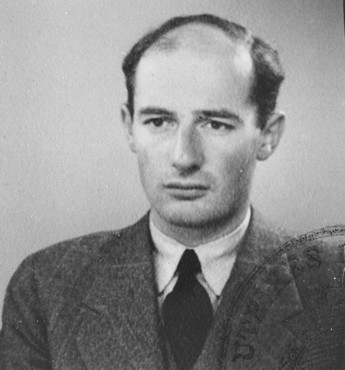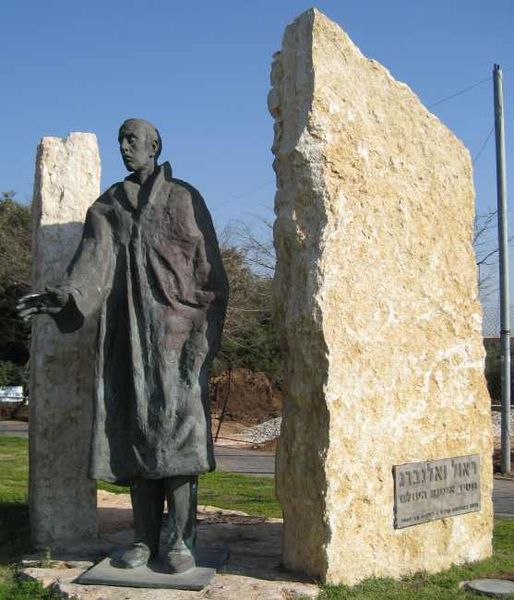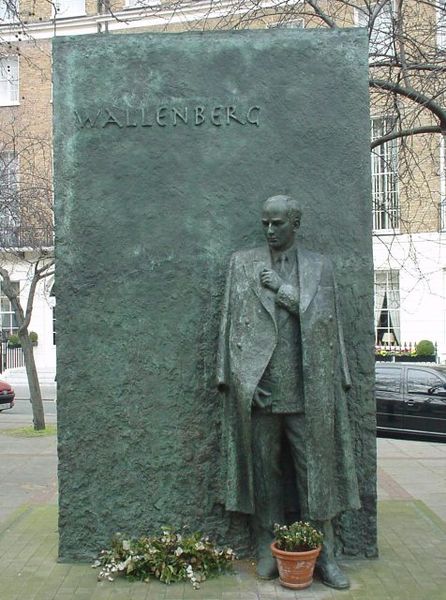<Back to Index>
- Mathematician Saunders Mac Lane, 1909
- Writer Walter Horatio Pater, 1839
- Diplomat Raoul Wallenberg, 1912
PAGE SPONSOR


Raoul Wallenberg (August 4, 1912 – July 17, 1947?) was a Swedish humanitarian who worked in Budapest, Hungary, during World War II to rescue Jews from the Holocaust. Between July and December 1944, he issued protective passports and housed Jews in buildings established as Swedish territory, saving tens of thousands of lives.
On January 17, 1945, he was called into detention by the Soviets after they entered Budapest,
and was reported to have died on July 7, 1947 while in their care. The
circumstances of his death have long been in question, with some
disputing whether he died while in Soviet detention. Wallenberg has been honored numerous times. He is an honorary citizen of Canada, Hungary, Israel and the United States. Israel has also designated Wallenberg one of the Righteous among the Nations. Monuments have been dedicated to him, and streets have been named after him throughout the world. A Raoul Wallenberg Committee of the United States was created in 1981 to "perpetuate the humanitarian ideals and the nonviolent courage of Raoul Wallenberg". It gives the Raoul Wallenberg Award annually to recognize persons who carry out those goals. Wallenberg was born in 1912 in Kappsta, Lidingö, near Stockholm,
where his maternal grandparents, professor Per Johan Wising and his
wife Sophie Wising, had built a summer house in 1882. His paternal
grandfather, Gustaf Wallenberg, was a diplomat and envoy to Tokyo, Istanbul and Sofia. His parents, who married in 1911, were Raoul Oscar Wallenberg (1888 – 1912), a Swedish naval officer who
died of cancer three months before his son was born, and Maria "Maj"
Sofia Wising (1891 – 1979). In 1918, his mother married Fredrik von
Dardel (d. 1979); they had a son, Guy von Dardel, and a daughter, Nina Lagergren. In 1931, Wallenberg went to study architecture at the University of Michigan in the United States. In college, he learned to speak English, German and French. He used his vacations to explore the United States. Although the Wallenberg family was wealthy, he worked at odd jobs in his free time. He joined other young men students as a passenger rickshaw handler at the Chicago's Century of Progress. On
his return to Sweden, he found his American degree did not qualify him
to practice as an architect. Eventually, his grandfather arranged a job
for him in Cape Town, South Africa, in the office of a Swedish company that sold construction material. Between 1935 and 1936, Wallenberg was employed in a minor position at a branch office of the Holland Bank in Haifa. He returned to Sweden in 1936 and obtained a job in Stockholm with the
help of his uncle and godfather, Jacob Wallenberg, at the Central
European Trading Company, an export - import company trading between Stockholm and central Europe, owned by Kálmán Lauer, a Hungarian Jew. In 1938, Hungary, under the regency of Miklós Horthy,
passed a series of anti - Jewish measures restricting professions,
reducing the number of Jews in government jobs, and prohibiting
intermarriage. Lauer found it increasingly difficult to travel to
Hungary, and Wallenberg became his trusted representative. Wallenberg
soon learned Hungarian, and from 1941 made frequent travels to Budapest. Within a year, Wallenberg was a joint owner and the International Director of the company. In
April and May 1944, although the loss of the war was a foregone
conclusion, the Germans and their Hungarian accomplices began the mass
deportation of Hungarian Jews, at the rate of 12,000 per day. The
persecution of the Jews in Hungary soon became well known abroad,
unlike the full extent of the Holocaust. In late spring 1944, George Mantello publicized what is now called the Wetzler - Vrba Report. World leaders Churchill, Roosevelt and others worked to assist Horthy in stopping the deportations. In spring 1944, U.S. President Franklin D. Roosevelt sent Iver Olsen to Stockholm as an official representative of the American War Refugee Board. He was looking for someone willing and able to go to Budapest to organize a rescue program for the Jews. Olsen believed that Wallenberg was the right man. On
August 10, 1944, Wallenberg traveled to Budapest as the First Secretary
to the Swedish legation in Budapest. Together with fellow Swedish
diplomat Per Anger, he issued "protective passports" (German: Schutz - Pass),
which identified the bearers as Swedish subjects awaiting repatriation
and thus prevented their deportation. Although not legal, these
documents looked official and were generally accepted by German and
Hungarian authorities, who sometimes were also bribed. The
Swedish legation in Budapest also succeeded in negotiating with the
Germans so that the bearers of the protective passes would be treated
as Swedish citizens and be exempt from having to wear the yellow badge required for Jews. With the money raised by the board, Wallenberg rented 32 buildings in Budapest and declared them to be extraterritorial, protected by diplomatic immunity.
He put up signs such as "The Swedish Library" and "The Swedish Research
Institute" on their doors and hung oversize Swedish flags on the front
of the buildings to bolster the deception. The buildings eventually
housed almost 10,000 people. Sandor
Ardai, one of the drivers working for Wallenberg, recounted what
Wallenberg did when he intercepted a trainload of Jews about to leave
for Auschwitz: At the height of the program, over 350 people were involved in the rescue of Jews. Sister Sára Salkaházi was caught sheltering Jewish women and was killed by members of the Arrow Cross Party. Swiss diplomat Carl Lutz also issued protective passports from the Swiss embassy in the spring of 1944; and Italian businessman Giorgio Perlasca posed as a Spanish diplomat and issued forged visas. Berber
Smit (Barbara Hogg), the daughter of Lolle Smit (1892 – 1961), director
of N.V. Philips Budapest and a Dutch spy working for the British MI6, also assisted Wallenberg. According to her son, she had a romance with him. Smit's other daughter, Reinderdina Petronella (1922 – 1945), died on 18 August 1945 in Bucharest. Wallenberg
started sleeping in a different house each night, to guard against
being captured or killed by Arrow Cross Party members or by Adolf Eichmann's men. Two days before the Russians occupied Budapest, Wallenberg negotiated with both Eichmann and General Gerhard Schmidthuber, the commander of the German army in Hungary. Wallenberg bribed Arrow Cross Party member Pál Szalai to deliver a note in which Wallenberg persuaded the Germans to cancel a final effort to organize a death march of the remaining Jews in Budapest by threatening to have them prosecuted for war crimes once the war was over. People saved by Wallenberg include biochemist Lars Ernster, who was housed in the Swedish embassy, and Tom Lantos, later a member of the United States House of Representatives, who lived in one of the Swedish protective houses. The Soviet Red Army closed in on Budapest in early 1945. On January 17, 1945, Wallenberg was called to Marshal Rodion Malinovsky's headquarters in Debrecen on suspicion of being a spy for the United States and that the War Refugee Board was engaged in espionage. Wallenberg's last recorded words were, "I'm going to Malinovsky's ... whether as a guest or prisoner I do not know yet." In 2003, a review of wartime Soviet correspondences indicated the agent Vilmos Böhm may have provided Wallenberg's name to Joseph Stalin as a person to detain. Information
about Wallenberg after his detention is mostly speculative; there were
many witnesses who claim to have met him during his imprisonment. Wallenberg was transported by train from Debrecen, through Romania, to Moscow. The Soviets may have moved him to their capital in hopes of exchanging him for defectors in Sweden. Vladimir
Dekanosov notified the Swedes on January 16, 1945 that Wallenberg was
under the protection of Soviet authorities. On January 21, 1945,
Wallenberg was transferred to Lubyanka prison and held in cell 123 with fellow prisoner Gustav Richter,
formerly a police attaché at the German embassy in Romania.
Richter testified in Sweden in 1955 that Wallenberg was interrogated
once for about an hour and a half, in early February 1945. On March 1,
1945, Richter was moved from his cell and never saw Wallenberg again. On
March 8, 1945, Soviet controlled Hungarian radio announced that
Wallenberg and his driver had been murdered on their way to Debrecen,
suggesting that they had been killed by the Arrow Cross Party or the Gestapo. Sweden's foreign minister, Östen Undén, and its ambassador to the Soviet Union, Staffan Söderblom, wrongly assumed that they were dead. In April 1945, William Averell Harriman of the U.S. State Department offered the Swedish government help in inquiring about Wallenberg’s fate, but the offer was declined. Söderblom met with Vyacheslav Molotov and Stalin in Moscow on
June 15, 1946. Söderblom, still believing Wallenberg to be dead,
ignored talk of an exchange for Russian defectors in Sweden. On
February 6, 1957, the Soviets released a document dated July 17, 1947,
which stated "I report that the prisoner Wallenberg who is well known
to you, died suddenly in his cell this night, probably as a result of a
heart attack or heart failure. Pursuant to the instructions given by
you that I personally have Wallenberg under my care, I request approval
to make an autopsy with a view to establishing cause of death... I have
personally notified the minister and it has been ordered that the body
be cremated without autopsy." The document was signed by Smoltsov, then the head of the Lubyanka prison infirmary, and addressed to Viktor Semyonovich Abakumov, the Soviet minister of state security. In
1989, the Soviets returned Wallenberg's personal belongings to his
family, including his passport and cigarette case. Soviet officials
said they found the materials when they were upgrading the shelves in a
store room. In
1991, Vyacheslav Nikonov was charged by the Russian government to
investigate Wallenberg's fate. He concluded that Wallenberg died in
1947, executed while a prisoner in Lubyanka. In Moscow in 2000, Alexander Nikolaevich Yakovlev announced that Wallenberg had been executed in 1947 in Lubyanka prison. He claimed that Vladimir Kryuchkov,
the former Soviet secret police chief, told him about the shooting in a
private conversation. The statement did not explain why Wallenberg was
killed or why the government had lied about it. Pavel Sudoplatov claimed that Raoul Wallenberg was poisoned by Grigory Mairanovsky. In 2000, Russian prosecutor Vladimir Ustinov signed a verdict posthumously rehabilitating Wallenberg and his driver, Langfelder, as "victims of political repression". A number of files pertinent to Wallenberg were turned over to the chief rabbi of Russia by the Russian government in September 2007. They will be housed at the Museum of Tolerance in Moscow, scheduled to open in 2011. Several former prisoners have claimed to have seen Wallenberg after his reported death in 1947. In February 1949, former German Colonel Theodor von Dufving, a prisoner of war, provided evidentiary statements concerning Wallenberg. While in the transit camp in Kirov, en route to Vorkuta,
Dufving encountered a prisoner with his own special guard and dressed
in civilian clothes. The prisoner claimed that he was a Swedish
diplomat and that he was there "through a great error." Renowned Nazi hunter Simon Wiesenthal searched for Wallenberg and collected several testimonies. For example, British businessman Greville Wynne, who was imprisoned in the Lubyanka prison in 1962 for his connection to KGB defector Oleg Penkovsky, stated he talked to, but could not see the face of, a man who claimed to be a Swedish diplomat. Efim (or Yefim) Moshinsky claims to have seen Wallenberg on Wrangel Island in 1962. An eyewitness asserted that she had seen Wallenberg in the 1960s in a Soviet prison. During a private conversation about the conditions of detention in Soviet prisons at a party reception in the mid 1970s, a KGB general is
reported to have said that "conditions could not be that harsh, given
that in Lubyanka prison there is some foreign prisoner who had been
there now for almost three decades". The
last reported sightings of Wallenberg were by two independent witnesses
who said they had evidence that he was in a prison in November 1987. A Swedish - Russian working group was set up in 1991 on Guy von Dardel's initiative to search eleven separate military and government archives from the former Soviet Union for information about Wallenberg's fate. Raoul Wallenberg's brother, Professor Guy von Dardel, a well - known physicist, retired from CERN, was dedicated to finding out his half-brother's fate. He
traveled to the Soviet Union about fifty times for discussions and
research, including an examination of the Vladmir prison records. Over
the years, Professor von Dardel had compiled a 50,000-page archive of
interviews, journal articles, letters, and other documents related to
his quest. Many,
including Professor von Dardel and his daughters Louise and Marie, do
not accept the various versions of Wallenberg's death. They continue to
request that the archives in Russia, Sweden and Hungary be opened to
impartial researchers. Wallenberg's
niece, Louise von Dardel, is the main activist in the family and
dedicates much of her time to speaking about Wallenberg and lobbying
various countries to help uncover information about her uncle. In April 1952, Hungarian State Protection Authority (Hungarian: Államvédelmi Hatóság or ÁVH)
kidnapped Miksa Domonkos, László Benedek and Lajos
Stöckler, three leaders of the Jewish community in Budapest, to
extract confessions. Two purported eyewitnesses – Pál Szalai and Károly Szabó – were also arrested and interrogated using torture.
This was in preparation for a show trial to be mounted in 1953 by the
Hungarian ÁVH to prove that Wallenberg had not been moved to the
Soviet Union in 1945, but was the victim of cosmopolitan Zionists. The idea that the "murderers of Wallenberg" were Budapest Zionists was primarily supported by Hungarian Communist leader Ernő Gerő, demonstrated by a note sent by him to First Secretary Mátyás Rákosi. The show trial was to be held in Moscow. But, after the death of Stalin and Lavrentiy Beria,
the AVH stopped preparations for the trial and released the prisoners.
Domonkos spent a week in the hospital and died at home shortly
afterward, mainly due to the torture he had suffered. Raoul's
mother and stepfather both committed suicide by overdosing on pills two
days apart in 1979. Their daughter Nina Lagergren, Raoul's half-sister,
attributed their suicide to their despair about never finding their son. Nina's daughter, Nane Maria Lagergren, married Kofi Annan.
